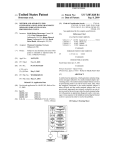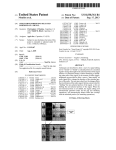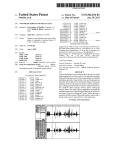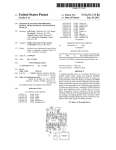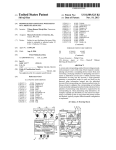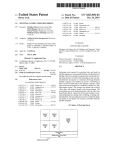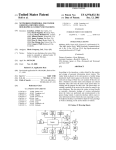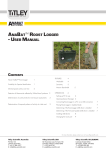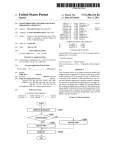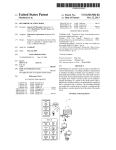Download I . ` ll 1
Transcript
US008295682B1 (12) Ulllted States Patent (10) Patent N0.: Bhatt (54) (45) Date of Patent: 2002/0188602 A1 * SEGMENTS OFA SIGNAL 2003/00l4l35 Al l/2003 Moulios 2003/0067554 Al * 4/2003 Klarfeld et al. ............. .. 348/461 2003/0084065 Al * 5/2003 Lin et al. .................. .. 707/1041 2003/0093445 A1 500% Schick et a1‘ Inventor: Nikhil M. Bhatt, Cupertino, CA (US) _ _ (73) Ass1gnee: Apple Inc., Cupertino, CA (US) (*) Notice: l2/2002 5/2003 2003/0123713 A1 7/2003 Geng .................. .. 725/38 2003/0190090 Al 10/2003 Beeman et a1. 2003/0227468 A1 12/2003 Takeda_ patent is extended or adjusted under 35 2004/0024758 A1 2/2004 Iwasakl (Continued) OTHER PUBLICATIONS Jul- 13, 2005 Higgins, D.,-“Wav-e-Corrector v3.0 Vinyl/Tape to CD-R Processing Digital Audio Editing for the PC User Manual,” Jul. 22, 2004, Ganymede Test & Measurement, v3 .0, from < http://WebarchiVeorg/ Int_ CL G11B 27/02 (52) Logan et al. Subject to any disclaimer, the term of this (21) Appl. N0.: 11/181,660 (22) FiladZ Stubler et a1. ................... .. 707/3 2003/0093790 Al * U.S.C. 154(b) by 2200 days. (51) Oct. 23, 2012 SELECTING PREVIOUSLY-SELECTED . (75) US 8,295,682 B1 (200601) Web/20040722l32002/WWW.Wavecor.co.uk/help300.pdf > (86 pgs). US. Cl. ..... .. 386/278; 386/282; 725/37; 369/4713; (Continued) 369/83; 715/723 (58) Field of Classi?cation Search .................. .. 386/46, Primary Examiner * Thai Tran 386/52, 95, 200, 230, 278, 281, 282; 369/3005, Assistant Examiner * MishaWn Dunn 369/4713, 83; 715/723, 732; 725/46, 37, (74) AZZ0rney,AgenZ, orFirm *Blakely, Sokoloff, Taylor& 725/ 44 Zafman LLP See application ?le for complete search history. (57) ( 56 ABSTRACT R f C't d e erences l 6 Techniques and interface controls are described Which allow us PATENT DOCUMENTS uslers 02signal editintg 2111pplicati1ons to1easily select previously se ecte segments 0 t e signa .Ast e user se ects segments ) 2 * 537523244 A g?'ilglircitgl'al" """""""" " 715/723 of the signal, the signal editing application automatically 5/199g Rose et a1‘ generates “selection history data”. The selection history data 5,999,173 A * 12/1999 Ubillos ....................... .. 715/724 6,069,995 A * 5/2000 sugiyama et a1~ ~~~~~~~~~~ ~~ 386/241 that is generated for a selected segment indicates the bound aries of the selected segment, and the sequence in Which the * 6:771:285 131* 7,055,166 B1* ‘sgg?it a1 8/2004 McGrath et a1" """"" 5/2006 Logan et a1, selected segment Was selected relative to other previously selected segments. The signal editing application provides controls for re-selecting the previously-selected segments 7,424,677 B2 * 725/l0l 715/723 725/32 9/2008 Sezan et a1. ................. .. 715/719 that are re?ected in the selection history data. In response to 7,454,010 B1 * 11/2008 Ebenezer 200 17/b700024gég E3120; 3 a1‘ """"" " 375/240'08 user-input received through these controls, the signal editing tool reselects a previously-selected segment based on the 2001/0020953 A1 >i< 2002/0010589 Al boundaries indicated in the selection history data. 2002/0180803 A1 9/2001 Moriwakeiet a1‘ “““““ “ 345/723 l/2002 Nashida et al. 12/2002 Kaplan et a1. l D'sPLAYm — T T 40 Claims, 3 Drawing Sheets _ _ T T 1 \ MAIN | MEMORY | T T _ _ T T _ _ T T T ROM i T T DEVICE 3116 3.116 _ ‘I i 1 SERVER i 3111 328 | l | II 31A T STORAGE l INPUT DEVICE T .‘ ___ :I ll BUS 1 1 11 ' — | 192 I 1 | | 1 1 I l \ | CURSOR I CONTROL ' 3113 <: “ 1 326 : PROCESSOQA COMMUNICATION INTERFACE m ' NETWORK | US 8,295,682 B1 Page 2 2004/0133927 2004/0139400 2004/0189827 2004/0199277 2005/0010475 2005/0063668 2005/0192924 2006/0041613 2006/0071942 2006/0071947 2006/0119619 2006/0248472 2009/0138829 U.S. PATENT DOCUMENTS 7/2004 Sternberg et al. 7/2004 9/2004 10/2004 1/2005 3/2005 9/2005 2/2006 4/2006 4/2006 6/2006 11/2006 5/2009 Allam et al. Kim et al. ................ .. 348/231.4 Bianchi et al. Perkowski et al. Hosoi et al. ................... .. 386/52 2010/0303257 A1 12/2010 Moulios et al. OTHER PUBLICATIONS U.S. Appl. No. 10/960,888, ?led Oct. 6, 2004, mailed Apr. 23, 2007. US. Appl. No. 11/104,995, ?ledApr. 12, 2005, Notice ofAlloWance, mailed Feb. 17, 2010. Fackelmayer et al. Sonic Foundry, Inc. “Sound Forge 6.0,” copyright 2002-2003, Sonic Foundry, Inc. pp. 1-14 and 129-142, http://WWW. Ubillos et al. Ubillos et al. U.S. Appl. No. 11/195,265, ?led Aug. 1, 2005, Final Of?ce Action, Fagans et al. mailed Mar. 18, 2011. Drucker et al. sonycreativesoftware.com/doWnload/manuals/soundforgefamily. Helie et al. .................. .. 715/810 Ogikubo ..................... .. 715/853 * cited by examiner US. Patent 106 108 0a. 23, 2012 110 112 Sheet 1 of3 US 8,295,682 B1 US. Patent 0a. 23, 2012 Sheet 2 of3 US 8,295,682 B1 US 8,295,682 B1 1 2 SELECTING PREVIOUSLY-SELECTED SEGMENTS OF A SIGNAL selected. A single signal editing application may provide numerous alternative techniques for selected segments of the signal. The techniques described herein are not limited to any particular techniques for selecting segments of a signal. FIELD OF THE INVENTION During the editing process, it may be desirable to perform The present invention relates to digital editing and, more a second editing operation on the same segment on Which a speci?cally, to editing signal data. ?rst editing operation Was previously performed. If the desired segment is still the currently selected segment, then BACKGROUND the segment does not have to be re-selected to perform the second operation. HoWever, if the desired segment is no longer selected, then the user must re-select the desired seg It is desirable, in a variety of contexts, to capture signals. The nature of the signals may vary from context to context. For example, in a medical context, it may be desirable to ment. Manually trying to re-select a previously selected segment capture signals that represent heart activity. In the context of sound studios, it may be desirable to capture audio signals produced by music artists. The techniques described herein is both tedious and error prone. If the user fails to select the exact boundaries of the previously selected segment, then the subsequent editing operation may create more problems that are not limited to any particular type of recorded signal. The digital representation of a signal is referred to herein as “sig nal data”. For a variety of reasons, it may be desirable to edit the signal data after a signal has been digitally recorded. For example, an audio recording of a lecture may include a cough that should be removed. In addition to problems created by 20 the recording environment (such as a coughing audience), the recording process itself may introduce problems, such as hissing or popping noises, that should be removed from the 25 it ?xes. For example, assume that a particular segment of an audio signal Was previously converted to “silence”. At a later is not able to select the exact boundaries of the segment that Was converted to silence, the attempt to convert the segment to ambient noise may leave a small segment of silence. To assist the user in selecting a previously selected seg Many signal editing applications are available forperform ments, the process of selecting previously-selected segments may still be cumbersome. 30 BRIEF DESCRIPTION OF THE DRAWINGS The present invention is illustrated by Way of example, and not by Way of limitation, in the ?gures of the accompanying being played. While listening to the audio and Watching the visual representation of the signal, the user may identify a 35 problem that requires ?xing. For example, the user may hear a “cough”, and see a spike that represents the cough in the visual representation of the signal. The user may then use a tool provided by the editing application to correct the prob lem. For example, the user may replace the segment of the signal that contains the cough With an ambient noise print, as described in US. patent application Ser. No. 11/104,995, ?led onApr. 12, 2005 entitled “PRESERVING NOISE DUR 40 Many editing operations are performed on selected seg ments of the signal, rather than on the entire signal. For example, in the operation mentioned above, the user replaces, With ambient noise, only the segment of the signal that con tains the cough. To alloW users to perform operations that draWings and in Which like reference numerals refer to similar elements and in Which: FIG. 1 is a block diagram of a navigation tool for selecting previously-selected segments of a signal, according to an embodiment of the invention; FIG. 2 is a block diagram that illustrates the visual depic tion of a signal, according to an embodiment of the invention; and FIG. 3 is a block diagram of a computer system upon Which embodiments of the invention may be implemented. ING EDITING OF A SIGNAL”, the contents of Which are incorporated herein by this reference. ment, the signal editing application may keep track of previ ously selected segments. HoWever, Without user interface tools that facilitate the selection of previously selected seg recording. ing post-recording edits to a captured signal. In the context of audio signals, many audio editing applications alloW a user to listen to the audio. While the audio is being played, the user is presented With a visual representation of the signal, With an indication of the location, Within the signal, that is currently point in the editing process, the user may decide to change that particular segment to ambient noise. HoWever, if the user 45 DETAILED DESCRIPTION In the folloWing description, for the purposes of explana tion, numerous speci?c details are set forth in order to provide cally have user interface controls that alloW a user to select a a thorough understanding of the present invention. It Will be apparent, hoWever, that the present invention may be prac ticed Without these speci?c details. In other instances, Well segment of the signal. knoWn structures and devices are shoWn in block diagram 50 involve segments of a signal, signal editing applications typi The speci?c user interface controls that a signal editing application provides for selecting a segment of a signal may vary from application to application. For example, one signal editing application may alloW a user to specify “markers” at form in order to avoid unnecessarily obscuring the present 55 invention. OvervieW user-selected points in the visual depiction of the signal. The user may then double-click the cursor betWeen tWo markers to automatically select the segment of the signal that is bounded by the tWo markers. As another example, a signal editing 60 application may alloW a user to select a segment by (1) press Techniques and interface controls are provided Which alloW users of signal editing applications to easily select previously-selected segments of a signal. According to one embodiment, as the user selects segments of the signal, the ing doWn on a mouse button at a ?rst point in the visual signal editing application automatically generates “selection depiction of the signal, (2) dragging the cursor to a second history data”. The selection history data that is generated for point in the visual depiction of the signal, and (3) releasing the mouse button. In response to releasing the mouse button, the a selected segment indicates the boundaries of the selected segment, and the sequence in Which the selected segment Was segment betWeen the ?rst point and the second point is selected relative to other previously-selected segments. To 65 US 8,295,682 B1 3 4 facilitate the identi?cation of the previously-selected seg ments, the selection history data may also include user-speci ?ed and/or automatically generated labels for some or all of cause segment S1 to be re-selected, since segment S1 imme diately precedes the currently selected segment (S2) Within the selection history data. Buttons 110 and 112 Would con tinue to be inactive, since there are no segments, Within the the previously-selected segments. The signal editing application provides controls for re selection history data, that folloW the currently-selected seg ment (S2). Assume that the user selects button 108, causing segment S1 to be re-selected. In addition to re-selecting segment S1, selecting the previously-selected segments that are re?ected in the selection history data. In response to user-input received through these controls, the signal editing tool rese lects a previously-selected segment based on the boundaries indicated in the selection history data. Various user interface selection of button 108 causes buttons 110 and 112 to become active. Button 110 becomes active because the selection his tory data includes an entry for a segment (S2) that folloWs the controls that facilitate the selection of previously-selected segments are described hereafter in greater detail. entry for the currently-selected segment (S1). Selection of button 110 at this point Would cause segment S2 to once again be selected, and button 110 to become inactive. Selection Navigation Tool It should be noted that the sequence used by broWsing tool Referring to FIG. 1, it is a block diagram of a selection 102 is the sequence in Which the segments Were selected, as indicated in the selection history data, and does not necessar navigation tool 100 for navigating through previously-se lected segments of a signal, according to one embodiment of the invention. Selection navigation tool 100 includes a broWs ing tool 102 and a random-access tool 104. 20 BroWsing tool 102 includes several buttons 106, 108, 110 and 112. In response to receiving user input that selects button ily correspond to the relative sequence of the segments Within the signal itself. Thus, segment S2 may be sequentially after segment S1 in the selection history data, even though segment S2 precedes segment S1 in the signal. 106, the signal editing application re-selects the ?rst segment Random Access Selection of Previously-Selected that is re?ected in the selection history data. In response to receiving user input that selects button 108, the signal editing application re-selects the segment, Within the selection his 25 tory data, that immediately precedes the currently selected Referring again to FIG. 1, navigation tool 100 also includes segment. In response to receiving user input that selects but ton 110, the signal editing application re-selects the segment, Within the selection history data, that immediately folloWs the Segments 30 currently-selected segment. In response to receiving user input that selects button 112, the signal editing application a random-access tool 104. Random-access tool 104 provides controls that alloW the user to directly select any of the seg ments re?ected in the selection history data. According to one embodiment, random-access tool 104 includes a control re-selects the last segment that is re?ected in the selection Which, When selected, presents the user With indicators for each of the segments re?ected in the selection history data. In history data. response to user input that selects one of the indicators, the According to one embodiment, the buttons of broWsing tool 102 are displayed With different visual depictions depending on Whether the operations that correspond to the the selected indicator. In the illustrated example, random-access tool 104 signal editing tool re-selects the segment that corresponds to buttons are available. For example, if the user has not yet selected any segment, then the selection history data Will be empty, and all of the buttons may be displayed as “inactive”. 40 For the purpose of illustration, assume that the user then selects a segment S1 of the signal. In response to the user’s includes a pull-doWn menu. When the pull-doWn menu con trol is selected, the user is presented With a list of menu items. The menu items are labels that correspond to the segments re?ected in the selection history data. In response to user input that selects the label associated With a particular seg selection of a segment, the signal editing application stores an entry in the selection history data for the segment S1. The entry may indicate the boundaries of S1, and that S1 is sequentially the ?rst segment that the user selected. At this point, buttons 106, 108, 110 and 112 may remain inactive, since there is no “?rst”, “previous”, “next” or “last” selected segment in the selection history data other than the currently selected segment. Buttons 106 and 108 become active When at least one segment precedes the currently ment, the signal editing application (1) selects the segment that corresponds to the selected label, (2) ceases to display the list of labels, and (3) displays the label associated With the selected segment. In the example shoWn in FIG. 1, the ran dom-access tool 104 displays the label “From ‘Start Talking’ to ‘End Talking’”, indicating that the segment associated With that label is the currently-selected segment. To facilitate the use of the random-access tool 104, the labels that are presented to the user should be meaningful to selected segment in the selection history data. Similarly, but the user. Various techniques for associating meaningful labels tons 110 and 112 become active When at least one segment With selected segments shall noW be described in greater detail. folloWs the currently selected segment in the selection history data. Assume that the user then selects another segment S2 of the signal. In response to the user’s selection of segment S2, the 55 User-Speci?ed Segment Labels signal editing application stores an entry in the selection history data for segment S2. The entry for S2 may indicate the boundaries of S2, and that S2 is sequentially the second tion may include controls that alloW users to specify the labels that are used to identify segments Within the selection history segment that the user selected. data. For example, While listening to playback of an audio At this point, buttons 106 and 108 may become active, since there is a previously-selected segment, Within the selec segment of the signal in Which the cough occurs, and assign According to one embodiment, the signal editing applica signal, a user may notice a cough. The user may then select the that segment the label “cough”. The signal editing application tion history data, that precedes the currently selected segment (S2). Selection of button 106 Would cause segment S1 to be re-selected, since segment S1 is the ?rst segment re?ected in the selection history data. Selection of button 108 Would 65 stores the label “cough” in the entry, Within the selection history data, for that particular segment. Consequently, at a future point in the editing process, the user may use the US 8,295,682 B1 5 6 random access tool 104 to select the label “cough” to cause Therefore, various techniques are provided by Which the user may explicitly or implicitly purge entries from the selection the segment of the audio signal that contains the cough to be selected. history data. Automatically Generated Segment Labels According to one embodiment, When a user moves through the selection history and then makes a neW selection, some Instead of or in addition to user-speci?ed labels, the signal editing tool may include a mechanism for automatically gen elements are automatically purged from the history. For example, a history may contain the folloWing selections: Selection 1 Selection 2 Selection 3 Selection 4 erating labels for selected segments. Such automatically gen erated labels may be stored in the selection history data, along With the other information about the previously-selected seg ments. A variety of techniques may be used to automatically gen erate meaningful labels for selected segments. The signal A user may navigate to Selection 2 and then make a neW Selection 5. According to one embodiment, selecting a neW editing application may, for example, create a label for a selection based on a variety of criteria, including but not segment after navigating to a particular previously-selected segment causes all segments that folloW the particular previ ously-selected segment to be purged from the history. After such a purge, the history Would contain the folloWing entries: limited to: start point, duration, frame, Zero-crossing points, and markers. For example, in an embodiment Where the boundaries of a selected segment are identi?ed by tWo mark ers, a label for the segment may be automatically generated based on the labels associated With the tWo markers. Thus, the label “From ‘Start Talking’ to ‘End Talking’” may be auto matically generated in response to user selection of a segment that extends from a marker labeled “Start Talking” to a marker labeled “End Talking”. Automatically generated labels may also re?ect other meaningful points Within the signal. For example, the label “From ‘Signal Start’ to ‘Start Talking’” may be automatically 20 Selection 1 Selection 2 Selection 5 Thus, Selections 3 and 4 have been removed from the history. 25 Automatically deleting subsequent entries in this manner is not alWays desirable, especially for user-named selections. According to one embodiment, user-named selections are not generated for a selected segment that extends from the begin ning of the signal to a marker that is labeled “Start Talking”. Similarly, the label “From ‘End Talking’” to ‘Signal End’ may be automatically generated for a selected segment that implicitly purged in this manner, but are retained and dis played in a separate user interface element. For example, such extends from a marker labeled “End Talking” to the end of the selections). recorded signal. Instead of or in addition to implicit purging, the user may be provided With controls that alloW the user to purge (1) all entries in the selection history, (2) all entries other than user user-named selections may be displayed in a pop-up menu betWeen the arroW buttons (Where users Would also name neW These are merely examples of techniques that may be used for automatically generating meaningful labels that are pre sented to the user by the random-access tool 104. The user may override such automatically-generated labels With user speci?ed labels, as described above. According to one 35 selected individual entries. In this manner, the user may retain the selection history entries for important segments, While still pruning the selection history list doWn to a manageable embodiment, the label associated With the currently-selected segment is displayed by navigation tool 100, regardless of Whether the segment Was selected using the broWsing tool number of entries. 40 Depicting the Selected Segment 102 or the random-access tool 104. Many signal editing applications generate visual depic Durably Storing the Selection History Data It is not uncommon for users to perform editing operations in multiple sessions. For example, a user may launch a signal 45 editing application, perform a feW edit operations, save the changes, and close the signal editing application. At a later point in time, the user may launch the signal editing applica tion again, perform a feW more edit operations, save the 50 changes, and close the signal editing application. During one editing session, the user may Want to perform that Was stored for the signal. As a result, the user is able to guishes the segment from the remainder of the signal. Representing Selection Boundaries 60 As mentioned above, the selection history data includes information that indicates the boundaries of previously-se lected signal segments. According to one embodiment, the boundaries are stored as sample ranges. For example, for a particular selection, the selection history data may include information about the sample numbers of the samples, Within the signal data, that correspond to the boundaries of the selec Clearing/ Purging Selection History Data 65 every segment that is selected during the editing of a signal. depiction of the signal is modi?ed accordingly. The modi? cation includes (l) depicting the portion of the signal that contains the neWly selected segment, and (2) depicting the 55 easily select in one session segments that Were previously selected in other sessions. It may not be necessary or even desirable to keep track of tions of a signal. An example of such a depiction is illustrated in FIG. 2. When a segment of the signal is selected, the selected segment is typically shoWn in a manner that visually distinguishes the selected segment from the rest of the signal. According to one embodiment, When the navigation tool 100 is used to select a previously-selected segment, the visual neWly selected segment in a manner that visually distin an edit operation to a segment that Was selected during a previous editing session. Therefore, according to one embodiment, the signal editing tool includes a mechanism for durably storing the selection history data Within, or in con junction With, the ?le that includes the signal data. When the signal editing application loads the signal data from the ?le, the signal editing application also loads selection history data labeled entries, (3) a selected range of entries, and/or (4) tion. Thus, in an audio ?le that includes 10,000 samples, a particular signal segment may correspond to sample 500 to sample 2000. When the particular segment is selected, the US 8,295,682 B1 7 8 signal editing application may store the range (500, 2000) in selection history data. For example, assume that the visual depiction of the signal is at Zoom level 5 When a segment S1 is selected. In response to the selection, the signal editing the selection history data to identify the selected segment. Unfortunately, due to insertion or deletion operations, the sample range that is stored in the selection history data to identify a previously-selected segment may no longer corre spond to the signal data that Was in the previously-selected aries of S1, (2) a sequence indicator for S1, (3) an automati cally-generated label for S1, and (4) an indication that S1 Was segment. For example, a user may select the ?rst 1000 selected at Zoom level 5. samples of a ?le, then insert 2000 samples at the front of the ?le, and then use the selection history. If only sample numbers are stored in the selection history data, then the selection level, and perform any number of subsequent operations. application stores in the selection history data (1) the bound After 51 has been selected, the user may change the Zoom HoWever, When the user uses the navigation tool 100 to re history Would highlight the ?rst 1000 samples, Which actually select segment S1, the signal editing application automati Were just inserted (and not the same ones that the user origi cally restores the Zoom level to Zoom level 5. nally selected). However, the data the user typically Wants under these circumstances is noW sample range 2000-2999, Which contains the “sounds” the user selected originally. Variations and Enhancements Based on the time range information, the proper range can be The selection history tools and techniques described herein re-selected. Instead of or in addition to using sample ranges, the bound aries of selections may be represented, Within the selection history data, by time ranges. Thus, a selected segment that may be enhanced in a variety of Ways. For example, in one embodiment, empty selections (Where there is a starting point 20 selection history data, by the time range (T5, T50). Unlike sample numbers, the time values associated With samples do not change When the samples are moved around Within the audio ?le. Thus, the use of time ranges to record the bound tWo selections are identical and are adjacent in the selection 25 aries of selections is especially useful When users are per forming insertion and deletion operations, and When users name selections [e.g., “cough”]. By storing the selections as time ranges, the signal editing application is able to adjust the selection history When insert/ deletes occur. In addition, if the selection history data stores both the sample range and the time range, then the signal editing application can provide users With the option ofjump ing to either the time-based selection or the sample range based selection. If the sample range does not equal the time range, then the signal editing application may ask the user (via preference or dialog) Which of the tWo ranges to use. On the other hand, if the sample range equals the time range, then the user Would not be asked. in the timeline, but Zero duration) can be optionally added to the selection history, via user preference. As another example, the signal editing tool may be con?gured to identify and merge the entries for identical selections. For example, When begins With a sample taken at time T5 and ending With a sample taken at time T50 may be represented, Within the 30 history, the signal editing tool may be con?gured to retain a selection history entry for only one of the selections. This techniques described herein can be applied in a variety of contexts, including audio Waveform applications, as Well for multitrack applications (in audio, video, or other timeline oriented applications). The techniques may be used to record selections made directly to data, as Well as to rulers, clips, and other such user interface elements. When applied to clips and other such Well-named elements, the automatic naming func tion is particularly useful. 35 HardWare OvervieW 40 FIG. 3 is a block diagram that illustrates a computer system 300 upon Which an embodiment of the invention may be implemented. Computer system 300 includes a bus 302 or other communication mechanism for communicating infor mation, and a processor 304 coupled With bus 302 for pro cessing information. Computer system 300 also includes a Storing Parameter Values in the Selection History Data main memory 306, such as a random access memory (RAM) According to one embodiment, various parameter values may be stored in the selection history data entry of a previ 45 ously-selected segment. The parameter values may re?ect, for example, the state of the signal editing application at the time that the segment Was originally selected. In response to user input that selects a previously- selected segment using the 50 navigation tool 100, the signal editing application assigns the parameter values from the segment’s entry to the correspond ing operational parameters of the signal editing application. As a result, selection of a previously-selected segment restores some properties of the signal editing tool to the state that the signal editing application Was in at the time the segment Was originally selected. For example, consider the visual depiction of the signal that is illustrated in FIG. 2. At any given time, the depiction of the signal represents the signal at a particular “Zoom” level. or other dynamic storage device, coupled to bus 302 for storing information and instructions to be executed by pro cessor 304. Main memory 306 also may be used for storing temporary variables or other intermediate information during execution of instructions to be executed by processor 304. Computer system 300 further includes a read only memory (ROM) 308 or other static storage device coupled to bus 302 for storing static information and instructions for processor 304. A storage device 310, such as a magnetic disk or optical disk, is provided and coupled to bus 302 for storing informa 55 tion and instructions. Computer system 300 may be coupled via bus 302 to a display 312, such as a cathode ray tube (CRT), for displaying information to a computer user. An input device 314, includ 60 communicating information and command selections to pro ing alphanumeric and other keys, is coupled to bus 302 for The Zoom level determines the number of pixels that are used per unit of the signal. Thus, at a loW Zoom level, a second’s cessor 304.Another type of user input device is cursor control 316, such as a mouse, a trackball, or cursor direction keys for Worth of audio signal may be depicted in 10 pixels along the communicating direction information and command selec x-axis. At a higher Zoom level, the same second’s Worth of tions to processor 304 and for controlling cursor movement audio signal may be depicted in 1000 pixels along the x-axis. The Zoom level of the visual depiction of the signal is an example of a parameter value that may be stored as part of the 65 on display 312. This input device typically has tWo degrees of freedom in tWo axes, a ?rst axis (e.g., x) and a second axis (e.g., y), that alloWs the device to specify positions in a plane. US 8,295,682 B1 10 The invention is related to the use of computer system 300 communication connection to a compatible LAN. Wireless for implementing the techniques described herein. According links may also be implemented. In any such implementation, communication interface 318 sends and receives electrical, electromagnetic or optical signals that carry digital data streams representing various types of information. NetWork link 320 typically provides data communication to one embodiment of the invention, those techniques are performed by computer system 300 in response to processor 304 executing one or more sequences of one or more instruc tions contained in main memory 306. Such instructions may be read into main memory 306 from another machine-read able medium, such as storage device 310. Execution of the sequences of instructions contained in main memory 306 causes processor 304 to perform the process steps described through one or more netWorks to other data devices. For example, netWork link 320 may provide a connection through local netWork 322 to a host computer 324 or to data equip ment operated by an Internet Service Provider (ISP) 326. ISP 326 in turn provides data communication services through the herein. In alternative embodiments, hard-Wired circuitry may be used in place of or in combination With software instruc tions to implement the invention. Thus, embodiments of the invention are not limited to any speci?c combination of hard Ware circuitry and softWare. World Wide packet data communication netWork noW com monly referred to as the “Internet” 328. Local netWork 322 and Internet 328 both use electrical, electromagnetic or opti The term “machine-readable medium” as used herein cal signals that carry digital data streams. The signals through refers to any medium that participates in providing data that the various netWorks and the signals on netWork link 320 and causes a machine to operation in a speci?c fashion. In an through communication interface 318, Which carry the digital embodiment implemented using computer system 300, vari ous machine-readable media are involved, for example, in providing instructions to processor 304 for execution. Such a 20 including program code, through the netWork(s), netWork medium may take many forms, including but not limited to, non-volatile media, volatile media, and transmission media. Non-volatile media includes, for example, optical or mag netic disks, such as storage device 310. Volatile media includes dynamic memory, such as main memory 306. Trans mission media includes coaxial cables, copper Wire and ?ber link 320 and communication interface 318. In the Internet example, a server 330 might transmit a requested code for an 25 30 puter system 300 may obtain application code in the form of a carrier Wave. In the foregoing speci?cation, embodiments of the inven the instructions carried by the media to be detected by a physical mechanism that reads the instructions into a machine. Common forms of machine-readable media include, for application program through Internet 328, ISP 326, local netWork 322 and communication interface 318. The received code may be executed by processor 304 as it is received, and/or stored in storage device 310, or other non-volatile storage for later execution. In this manner, com optics, including the Wires that comprise bus 302. Transmis sion media can also take the form of acoustic or light Waves, such as those generated during radio -Wave and infra-red data communications. All such media must be tangible to enable data to and from computer system 300, are exemplary forms of carrier Waves transporting the information. Computer system 300 can send messages and receive data, tion have been described With reference to numerous speci?c 35 example, a ?oppy disk, a ?exible disk, hard disk, magnetic tape, or any other magnetic medium, a CD-ROM, any other details that may vary from implementation to implementa tion. Thus, the sole and exclusive indicator of What is the invention, and is intended by the applicants to be the inven tion, is the set of claims that issue from this application, in the speci?c form in Which such claims issue, including any sub sequent correction. Any de?nitions expressly set forth herein optical medium, punchcards, papertape, any other physical medium With patterns of holes, a RAM, a PROM, and EPROM, a FLASH-EPROM, any other memory chip or car 40 for terms contained in such claims shall govern the meaning of such terms as used in the claims. Hence, no limitation, tridge, a carrier Wave as described hereinafter, or any other element, property, feature, advantage or attribute that is not medium from Which a computer can read. Various forms of machine-readable media may be involved in carrying one or more sequences of one or more instructions to processor 304 for execution. For example, the instructions 45 expressly recited in a claim should limit the scope of such claim in any Way. The speci?cation and draWings are, accord ingly, to be regarded in an illustrative rather than a restrictive sense. may initially be carried on a magnetic disk of a remote com puter. The remote computer can load the instructions into its dynamic memory and send the instructions over a telephone line using a modem. A modern local to computer system 300 What is claimed is: 1. A method for selecting previously-selected segments of can receive the data on the telephone line and use an infra-red 50 a signal, the method comprising: transmitter to convert the data to an infra-red signal. An reading signal data from a ?le that is an encoding of said signal; infra-red detector can receive the data carried in the infra-red signal and appropriate circuitry can place the data on bus 302. Bus 302 carries the data to main memory 306, from Which processor 304 retrieves and executes the instructions. The based on the signal data read from the ?le, a signal editing 55 instructions received by main memory 306 may optionally be speci?es boundaries of a segment; in response to receiving the input, generating an entry and stored on storage device 310 either before or after execution storing the entry in selection history data; by processor 304. Computer system 300 also includes a communication interface 318 coupled to bus 302. Communication interface 318 provides a tWo-Way data communication coupling to a application generating a visual depiction of said signal; receiving, through a segment selection interface, input that 60 Wherein the selection history data includes a plurality of entries, Wherein said entry is one of the plurality of entries; netWork link 320 that is connected to a local netWork 322. For Wherein each entry of the plurality of entries corresponds example, communication interface 318 may be an integrated services digital netWork (ISDN) card or a modem to provide to a segment of said signal that Was previously selected a data communication connection to a corresponding type of telephone line. As another example, communication interface 318 may be a local area netWork (LAN) card to provide a data based on user interaction; 65 Wherein each entry of the plurality of entries includes infor mation that identi?es the boundaries of the correspond ing segment; US 8,295,682 B1 11 12 generating user interface controls that alloW a user of the 15. A non-transitory computer-readable medium carrying signal editing application to select a segment from instructions Which, When executed by one or more proces sors, causes the performance of the method recited in claim 14. among the segments that are identi?ed in said selection history data; and 16. The method of claim 10 further comprising providing a mechanism by Which users may specify labels for segments. in response to input that selects a segment identi?ed in said selection history data, reading information from the entry for the segment to determine the boundaries of the 17. A non-transitory computer-readable medium carrying segment, and establishing the segment as the currently instructions Which, When executed by one or more proces sors, causes the performance of the method recited in claim 16. selected segment Within said signal editing application; Wherein the method is performed by one or more comput ing devices. 18. The method of claim 10 further comprising: 2. The method of claim 1 Wherein each entry further displaying to a user the labels associated With the segments represented in the selection history data; includes a sequence value that indicates the sequence in Which the corresponding segment Was selected relative to receiving ?rst input that selects a label; and in response to the ?rst input, establishing segment associ ated With the label as the currently selected segment. When other segments re?ected in the selection history data Were selected. 3. A non-transitory computer-readable medium carrying 19. A non-transitory computer-readable medium carrying instructions Which, When executed by one or more proces sors, causes the performance of the method recited in claim 2. 4. The method of claim 2 Wherein the user interface con trols include controls that alloW a user to broWse through the instructions Which, When executed by one or more proces sors, causes the performance of the method recited in claim 18. 20 segments re?ected in the selection history data in an order that re?ects the sequence values stored in the entries Within the selection history data. 5. A non-transitory computer-readable medium carrying 25 instructions Which, When executed by one or more proces sors, causes the performance of the method recited in claim 20. instructions Which, When executed by one or more proces sors, causes the performance of the method recited in claim 4. 6. The method of claim 4 Wherein: the user interface controls include a control for selecting 30 selected segment; and ment that precedes the currently selected segment. 7. A non-transitory computer-readable medium carrying that identi?es a time range, of the corresponding seg 35 40 the segment that immediately folloWs the currently selected segment; and the control is displayed in an inactive state When the selec tion history data does not include an entry for any seg 9. A non-transitory computer-readable medium carrying 26. A non-transitory computer-readable medium carrying 50 and a second user-speci?ed point on the visual depiction of 55 12. The method of claim 10 further comprising automati cally generating the label associated With a segment in 14. The method of claim 1, Wherein: said signal. 28. A non-transitory computer-readable medium carrying instructions Which, When executed by one or more proces sors, causes the performance of the method recited in claim response to user selection of the segment. instructions Which, When executed by one or more proces sors, causes the performance of the method recited in claim 12. instructions Which, When executed by one or more proces sors, causes the performance of the method recited in claim 1. 27. The method of claim 1, Wherein the input speci?es a ?rst user-speci?ed point on the visual depiction of said signal 11. A non-transitory computer-readable medium carrying 13. A non-transitory computer-readable medium carrying 25. A non-transitory computer-readable medium carrying instructions Which, When executed by one or more proces sors, causes the performance of the method recited in claim 24. instructions Which, When executed by one or more proces sors, causes the performance of the method recited in claim 8. instructions Which, When executed by one or more proces sors, causes the performance of the method recited in claim 10. 24. The method of claim 1 Wherein the information, Within an entry, that identi?es the boundaries of the corresponding segment includes information that identi?es both a time range of the corresponding segment, and a sample range of the corresponding segment. 45 ment that folloWs the currently selected segment. 10. The method of claim 1 Wherein each entry further includes a label associated With the corresponding segment. ment, relative to the starting point of the signal. 23. A non-transitory computer-readable medium carrying instructions Which, When executed by one or more proces sors, causes the performance of the method recited in claim 22. instructions Which, When executed by one or more proces sors, causes the performance of the method recited in claim 6. 8. The method of claim 4 Wherein: the user interface controls include a control for selecting 22. The method of claim 1 Wherein: the signal that is encoded in the ?le has a starting point; and the information, Within an entry, that identi?es the bound aries of the corresponding segment includes information the segment that immediately precedes the currently the control is displayed in an inactive state When the selec tion history data does not include an entry for any seg 20. The method of claim 1 further comprising durably storing the selection history data that Was generated during one editing session of the signal, and reloading the selection history data during a subsequent editing session of the signal. 21. A non-transitory computer-readable medium carrying 27 . 60 29. The method of claim 1, Wherein the information, Within an entry of the plurality of entries, that identi?es the bound aries of the corresponding segment includes information that identi?es a sample range of the corresponding segment. 30. A non-transitory computer-readable medium carrying the segment is selected based on one or more markers; and 65 instructions Which, When executed by one or more proces the label for the segment is automatically generated based on labels associated With the one or more markers. sors, causes the performance of the method recited in claim 29. US 8,295,682 B1 14 13 storing the ?rst entry in selection history data; receiving second input that causes the signal editing appli 31 . A method for selecting previously-selected segments of a signal, the method comprising: a signal editing application generating a visual depiction of cation to perform a second edit operation on a second said signal; segment of the signal, Wherein the second segment of the signal is modi?ed based on the performance of the sec generating selection history data in response to user inter action With a segment selection interface that includes ond edit operation; the visual depiction of said signal; generating a second entry in response to performing the second edit operation on the second segment, Wherein the second entry corresponds to the second segment on Which the second edit operation Was performed; Wherein the selection history data includes a plurality of entries; Wherein each entry of the plurality of entries corresponds to a segment of said signal that Was selected during said storing the second entry in the selection history data; user interaction; generating user interface controls that alloW a user of the signal editing application to select a segment from among the segments identi?ed in said selection history Wherein each entry includes information that identi?es the boundaries of the corresponding segment; data; and storing, in an entry, of the plurality of entries, that is asso ciated With a particular segment, one or more parameter in response to third input that selects a particular segment values, of the signal editing application, that Were in identi?ed in said selection history data, reading infor mation from the entry that corresponds to the particular segment to determine the boundaries of the particular segment, and establishing the particular segment as the effect at the time the particular segment Was selected, Wherein the one or more parameter values re?ect the state of the signal editing application at the time the particular segment Was originally selected; and in response to input that re-selects the particular segment 20 currently selected segment Within said signal editing application; Wherein the method is performed by one or more comput based on said selection history data, assigning the one or more parameter values to operational parameters of said signal editing application; ing devices. 25 generating the user interface controls comprises displaying Wherein the method is performed by one or more comput ing devices. a list of labels, Wherein each label in the list corresponds to an entry of the plurality of entries; and the third input selects a label that corresponds to the par 32. The method of claim 31 Wherein: the signal editing application generates a visual depiction of the signal. 33. A non-transitory computer-readable medium carrying ticular segment. 37. A non-transitory computer-readable medium carrying instructions Which, When executed by one or more proces sors, causes the performance of the method recited in claim 32. 34. A non-transitory computer-readable medium carrying 35 audio signal is displayed. 39. A non-transitory computer-readable medium carrying 35.A method for selecting segments of a signal, the method 40 receiving ?rst input that causes a signal editing application to perform a ?rst edit operation on a ?rst segment of the signal, Wherein the ?rst segment of the signal is modi?ed based on the performance of the ?rst edit operation; generating a ?rst entry in response to performing the ?rst edit operation on the ?rst segment, Wherein the ?rst entry corresponds to the ?rst segment on Which the ?rst edit operation Was performed; instructions Which, When executed by one or more proces sors, causes the performance of the method recited in claim 36. 38. The method of claim 35, Wherein: the signal is an audio signal; the ?rst input is received While a visual depiction of the instructions Which, When executed by one or more proces sors, causes the performance of the method recited in claim 31. comprising: 36. The method of claim 35, Wherein: instructions Which, When executed by one or more proces sors, causes the performance of the method recited in claim 38. 40. A non-transitory computer-readable medium carrying 45 instructions Which, When executed by one or more proces sors, causes the performance of the method recited in claim 35.












